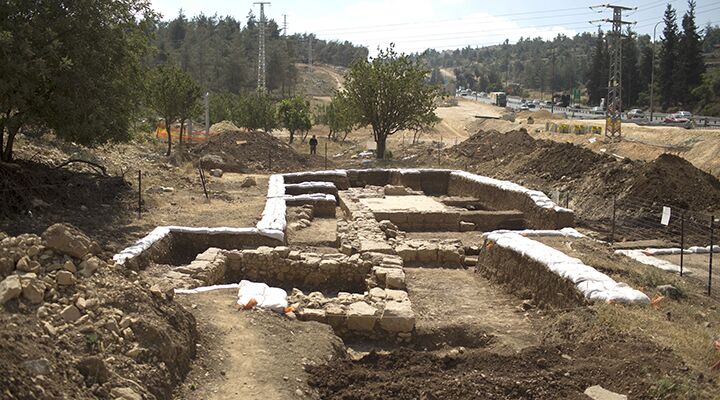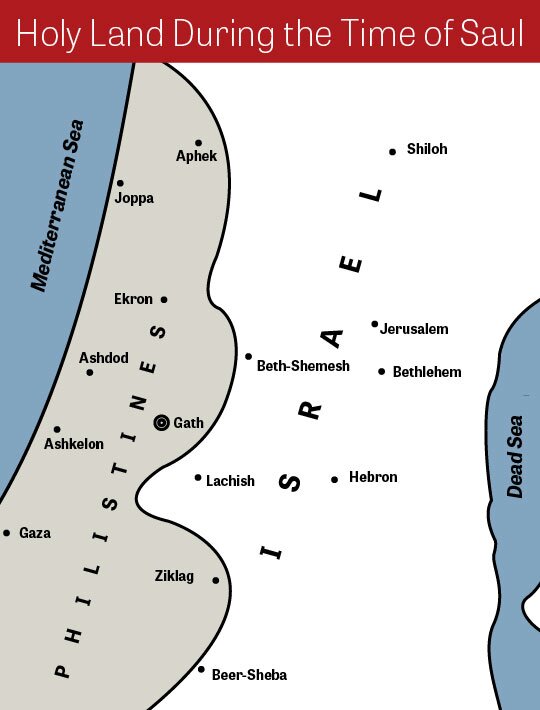
Massive Gate Found in Goliath’s Hometown
The iconic story of young David’s epic encounter with Goliath has captured imaginations for millennia. The classic underdog narrative resonates with all people as they face insurmountable odds—their figurative giants. But is the history of David and Goliath, as well as the history of their respective nations, only figurative, or is the history as the Bible describes a literal account of what took place?
A recent discovery in archaeological excavations at Goliath’s hometown of Gath is helping provide the answer.
The biblical city of Gath has been excavated extensively over the past 100 years. However, it was only at an archaeological dig this past summer that excavators happened upon a huge city wall and adjacent gate.
According to head archaeologist Prof. Aren Maeir of Bar-Ilan University in Israel, his team began to excavate the lower city of the mound (also known as Tel es-Safi) to determine whether it had been fortified during the Iron Age, the archaeological period in which the nation of Israel was also present in the land.
“In the past, we saw evidence of this but could not find definite proof,” Professor Maeir told Bible History Daily. “Once the remains were found in the specific trench, we ‘connected the dots’ regarding other features we could see on the surface and then began excavating them as well.”

Before long, the outline of a massive gate began to literally emerge from the ground. Excavators only discovered the top of the fortification and gate during this season, so only the very top of the wall is visible. It will take many more excavation seasons to reveal the full height of the remains.
While the exact dimensions of the gate at the entrance to the city are yet to be released, Maeir claims that “the city gate is among the largest ever found in Israel and is evidence of the status and influence of the city of Gath during this period.”
Indeed it does.
The fact that Gath was a prominent city during the time of King Saul and King David perfectly correlates with history related in the Bible.
Even so, some, including the archaeologist heading the excavation, say that this discovery presents a history contradictory to the Bible.
According to reporting by left-leaning Israel daily Haaretz, Maier said, “The Judean kingdom is supposed to be big, important and strong, but it turns out there is a very big city on its western border. For years, I claimed Gath was a big city, but they countered that it has no lower city, and if it has one, it is not fortified. After finding a huge fortification, it’s clearly the most important city of the 10th and ninth centuries.”
This hasty logic is surprising from such a distinguished scholar. The fact that a formidable city existed on the border of Israel does not exclude Israel from being “big, important and strong.”
In so many cases, as well as this one, a verdict is given about the veracity of the Bible without a proper understanding of what the text actually states.
So what does the Bible say about Israel and the Philistines at the time?
The Bible states that Gath was one of the five major cities of the Philistines (1 Samuel 6:17). While there is no real indication that the Philistines were a major power when Israel conquered the Promised Land during the time of Joshua, the Philistines do appear prominently in the later period of the judges, leading up to the establishment of the monarchy in Israel.
Because of the repetitive sins of Israel, God allowed the Philistines to oppress the Israelites during the time of the judges, at which point God raised up the mighty Danite Samson. Though Samson had his own problems, God used him to knock back the rising power of the Philistines. In his final act, as he was tied between two central pillars of a Philistine building in Gaza, Samson brought the house down on Philistine leadership, giving the Israelites a short reprieve (Judges 16:29-30).
However, it didn’t take long until a resurgent Philistine nation battled again with Israel at the very end of the period of the judges. At which time, the precious ark of the covenant was lost and the nation’s hope dwindled. Through the next 80 years (during the reigns of Saul and David), the Philistines and the Israelites battled back and forth, with the borderland between the two witnessing almost constant warfare. In reality, an outside political observer at the time would be hard pressed to guess which of the two nations would rise to eventual dominance over the other.
Throughout the reign of King Saul and into the reign of David, the Philistines maintained the upperhand on Israel. The Bible states directly that Philistine garrisons existed in such Israelite cities as Bethlehem and Gibeon (1 Samuel 10:5; 2 Samuel 23:14). The Philistines were so powerful that Israel was forbidden to sharpen their own iron tools, instead they had to go down to the Philistines who charged an exorbitant price (1 Samuel 13:19-21).
When the Israelites finally did overcome the Philistines during the reign of David, there is no mention of a messy destruction of Philistine cities (2 Samuel 8:1; 1 Chronicles 18:1). Unlike many other surrounding nations, the Philistines were neither absorbed into the kingdom of Israel or exiled elsewhere, but were able to continue living in their home territories, yet under Israelite rule. In fact, nowhere in the Bible is there a mention of Israel destroying the city of Gath, not until 200 years after King David, during the reign of Uzziah (2 Chronicles 26:6).
Rather than countering the biblical narrative, an honest look at the text should lead scholars to expect to find such massive Philistine fortifications such as the gatehouse at Gath. The fact that the gate is similar in size to some of the largest found in Israel fits the scenario described in the Bible most beautifully.
While no single artifact or discovery can “prove the Bible true,” discoveries such as the one at Gath certainly do add to the weight of evidence archaeology has contributed to confirming the accuracy of the biblical account.
Congratulations to the excavation team at Gath for such a wonderful discovery. We look forward to next year’s season when more of the gate of Gath is uncovered.
